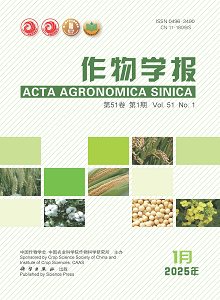花生耐三唑嘧啶除草剂种质资源的创建与鉴定
引用次数: 0
摘要
目前,耐除草剂花生(Arachis hypogaea)种质资源匮乏,制约了花生为主种植体系的多样化发展。为了培育耐除草剂的花生种质资源,采用甲基磺酸乙酯诱变方法,建立了5.5万多个花生品系的突变体群体。我们用多种不同的除草剂筛选该种群,获得对不同除草剂具有耐受性的多个突变体。其中1个品系对florasulam和flumetsulam表现出较强的耐受性,在田间条件下叶面喷施除草剂试验和各种室内除草剂耐受性评价中,耐除草剂性状对花生产量和品质没有不利影响。为了确定这一性状是否与基于靶点的除草剂抗性相关,我们比较了突变型和野生型作为除草剂靶酶的这两种乙酰羟基酸合成酶(AHASs)的基因序列和相对表达水平。分子克隆和序列分析表明,花生染色体A10和B10各含有一个基因,命名为AhAHAS1a和AhAHAS1b,与拟南芥AHAS高度相似。花生染色体A08和B08也分别携带一个AHAS基因,分别命名为AhAHAS2a和AhAHAS2b。然而,与野生型相比,突变型和野生型。综上所述,这些结果表明该突变体的除草剂耐受性可能是由非靶点抗性机制引起的。本文章由计算机程序翻译,如有差异,请以英文原文为准。
Creation and identification of peanut germplasm tolerant to triazolopyrimidine herbicides
: At present, the germplasm resources of herbicide-tolerant peanut ( Arachis hypogaea ) are scarce, which restrict the di-versification of peanut-based cropping system. To create peanut germplasm with tolerance to different herbicides, a mutant popu-lation consisting of more than 55,000 peanut lines were generated by ethylmethanesulfonate mutagenesis. We screened this popu-lation with a variety of different herbicides to obtain multiple mutants with tolerance to different herbicides. One of these lines displayed strong tolerance to florasulam and flumetsulam in the experiments with foliar herbicide spraying under field conditions as well as in various laboratory evaluation for the herbicide tolerance, while the herbicide-tolerant trait did not have adverse effects on peanut yield and quality. To determine whether this trait was associated with a target-site-based resistance to the herbicides, we compared gene sequences and relative expression levels of these two acetohydroxyacid synthases (AHASs) as the herbicide target enzymes between the mutant and wild type. Molecular cloning and sequence analysis revealed that peanut chromosome A10 and B10 each contained a gene, named as AhAHAS1a and AhAHAS1b , which were highly similar to Arabidopsis AHAS . Peanut chromosome A08 and B08 also each carried an AHAS gene, named as AhAHAS2a and AhAHAS2b , respectively. However, compared with the wild type, mutant and wild type. In summary, these results indicate that the herbicide tolerance of the mutant might be caused by non-target-site-based resistance mechanism.
求助全文
通过发布文献求助,成功后即可免费获取论文全文。
去求助
来源期刊

作物学报
Agricultural and Biological Sciences-Agronomy and Crop Science
CiteScore
1.70
自引率
0.00%
发文量
89
期刊介绍:
The major aims of AAS are to report the progresses in the disciplines of crop breeding, crop genetics, crop cultivation, crop physiology, ecology, biochemistry, germplasm resources, grain chemistry, grain storage and processing, bio-technology and biomathematics etc. mainly in China and abroad. AAS provides regular columns for Original papers, Reviews, and Research notes. The strict peer-review procedure guarantees the academic level and raises the reputation of the journal. The readership of AAS is for crop science researchers, students of agricultural colleges and universities, and persons with similar academic level.
 求助内容:
求助内容: 应助结果提醒方式:
应助结果提醒方式:


